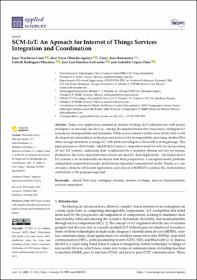Mostrar el registro sencillo del ítem
SCM-IoT: An Aproach for Internet of Things Services Integration and Coordination
| dc.contributor.author | Machorro-Cano, Isaac | |
| dc.contributor.author | Olmedo-Aguirre, José Oscar | |
| dc.contributor.author | Alor-Hernández, Giner | |
| dc.contributor.author | Rodríguez-Mazahua, Lisbeth | |
| dc.contributor.author | Sánchez-Cervantes, José Luis | |
| dc.contributor.author | López-Chau, Asdrúbal | |
| dc.date.accessioned | 2022-06-28T15:12:50Z | |
| dc.date.available | 2022-06-28T15:12:50Z | |
| dc.date.issued | 2022-03-18 | |
| dc.identifier.issn | 2076-3417 | |
| dc.identifier.other | https://doi.org/10.3390/app12063133 | |
| dc.identifier.uri | http://repositorios.orizaba.tecnm.mx:8080/xmlui/handle/123456789/561 | |
| dc.description | Today, new applications demand an internet of things (IoT) infrastructure with greater intelligence in our daily use devices. Among the salient features that characterize intelligent IoT systems are interoperability and dynamism. While service-oriented architectures (SOA) offer a well-developed and standardized architecture and protocols for interoperability, answering whether SOA offers enough dynamism to merge IoT with artificial intelligence (AI) is still in its beginnings. This paper proposes an SOA model, called SCM-IoT (service composition model for IoT), for incorporating AI into IoT systems, addressing their coordination by a mediator offering services for storage, production, discovery, and notification of relevant data for client applications. The model allows IoT systems to be incrementally developed from three perspectives: a conceptual model, platform-independent computational model, and platform-dependent computational model. Finally, as a case of study, a domotic IoT system application is developed in SCM-IoT to analyze the characteristics and benefits of the proposed approach. | es |
| dc.description.abstract | Today, new applications demand an internet of things (IoT) infrastructure with greater intelligence in our daily use devices. Among the salient features that characterize intelligent IoT systems are interoperability and dynamism. While service-oriented architectures (SOA) offer a well-developed and standardized architecture and protocols for interoperability, answering whether SOA offers enough dynamism to merge IoT with artificial intelligence (AI) is still in its beginnings. This paper proposes an SOA model, called SCM-IoT (service composition model for IoT), for incorporating AI into IoT systems, addressing their coordination by a mediator offering services for storage, production, discovery, and notification of relevant data for client applications. The model allows IoT systems to be incrementally developed from three perspectives: a conceptual model, platform-independent computational model, and platform-dependent computational model. Finally, as a case of study, a domotic IoT system application is developed in SCM-IoT to analyze the characteristics and benefits of the proposed approach. | es |
| dc.description.sponsorship | TECNM, CONACYT, PRODEP | es |
| dc.language.iso | en_US | es |
| dc.publisher | MDPI Publishing | es |
| dc.relation.ispartofseries | Applied Sciences; | |
| dc.subject | colored petri nets | es |
| dc.subject | intelligent systems | es |
| dc.subject | Internet of Things | es |
| dc.subject | services interoperability | es |
| dc.subject | services composition | es |
| dc.subject | Research Subject Categories::TECHNOLOGY | es |
| dc.title | SCM-IoT: An Aproach for Internet of Things Services Integration and Coordination | es |
| dc.type | Article | es |
Ficheros en el ítem
Este ítem aparece en la(s) siguiente(s) colección(ones)
-
Artículos (DCI) [72]



